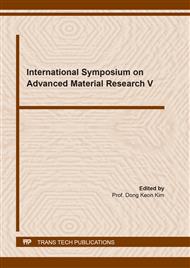[1]
S. Blien, P. Steger, N. Hüttner, et al., Quantum capacitance mediated carbon nanotube optomechanics, Nat. Commun. 11 (2020) 1636.
DOI: 10.1038/s41467-020-15433-3
Google Scholar
[2]
Z. Huang, P.J. Dyson, Depletion Effect-mediated Association of Carbon Nanotube-Polymer Composites and Their Application as Inexpensive Electrode Support Materials, Nano Lett. 20 (2020) 5353-5358.
DOI: 10.1021/acs.nanolett.0c01718
Google Scholar
[3]
J.Y. Huang, S. Chen, Z.Q. Wang, et al., Superplastic carbon nanotubes, Nat., 439 (2006) 281.
Google Scholar
[4]
A. Taloni, M. Vodret, G. Costantini, et al., Size effects on the fracture of microscale and nanoscale materials, Nat. Rev. Mater. 3 (2018) 211-224.
DOI: 10.1038/s41578-018-0029-4
Google Scholar
[5]
Y.R. Jeng, P.C. Tsai, S.H. Chiang, Effects of grain size and orientation on mechanical and tribological characterizations of nanocrystalline nickel films, Wear 303 (2013) 262-268.
DOI: 10.1016/j.wear.2013.02.019
Google Scholar
[6]
P.C. Tsai, Y.R. Jeng, T.H. Fang, A molecular dynamics study of the nucleation, thermal stability and nanomechanics of carbon nanocones, Nanotechnology 18 (2007) 105702.
DOI: 10.1088/0957-4484/18/10/105702
Google Scholar
[7]
P.C. Tsai, Y.R. Jeng, Experimental and numerical investigation into the effect of carbon nanotube bucklingon the reinforcement of CNT/Cu composites, Compos. Sci. Tech. 79 (2013) 28-34.
DOI: 10.1016/j.compscitech.2013.02.003
Google Scholar
[8]
P.C. Tsai, Y.R. Jeng, Theoretical investigation of thermally induced coalescence mechanism of single-wall carbon nanohorns and their mechanical properties, Comput. Mater. Sci. 88 (2014) 76-80.
DOI: 10.1016/j.commatsci.2014.02.024
Google Scholar
[9]
Y.R. Jeng, Y.H. Huang, P.C. Tsai, et al., Tribological Properties of Carbon Nanocapsule Particles as Lubricant Additive, J. Tribol. 136 (2014), 041801.
DOI: 10.1115/1.4027994
Google Scholar
[10]
L. Chang, Y.R. Jeng, P.Y. Huang, Modeling and analysis of the meshing losses of involute spur gears in high-speed and high-load conditions, ASME J. Tribol. 135 (2013) 11504.
DOI: 10.1115/1.4024104
Google Scholar
[11]
Jeng, Y.R. Jeng, C.M. Tan, Study of nanoindentation using FEM atomic model, ASME J. Tribol. 126 (2004) 767-774.
DOI: 10.1115/1.1792679
Google Scholar
[12]
Y.R. Jeng, S.H. Chang, Comparison between the effects of single-pad and double-pad aerostatic bearings with pocketed orifices on bearing stiffness, Tribol. Int. 66 (2013) 12-18.
DOI: 10.1016/j.triboint.2013.04.003
Google Scholar
[13]
P.C. Tsai, Y.R. Jeng, Effects of nanotube size and roof-layer coating on viscoelastic properties of hybrid diamond-like carbon and carbon nanotube composites, Carbon 86 (2015) 163-173.
DOI: 10.1016/j.carbon.2015.01.012
Google Scholar
[14]
P.C. Tsai, Y.R. Jeng, Coalescence and epitaxial self-assembly of Cu nanoparticles on graphene surface: A molecular dynamics study, Comput. Mater. Sci. 156 (2019) 104-110.
DOI: 10.1016/j.commatsci.2018.09.039
Google Scholar
[15]
Y. R. Jeng, P.C. Tsai, T.H. Fang, Effects of temperature and vacancy defects on tensile deformation of single-walled carbon nanotubes, J. Phys. Chem. Solids 65 (2004) 1849-1856.
DOI: 10.1016/j.jpcs.2004.07.001
Google Scholar
[16]
Y. R. Jeng, P.C. Tsai, T.H. Fang, Molecular-dynamics studies of bending mechanical properties of empty and C60-filled carbon nanotubes under Nanoindentation, J. Chem. Phys. 122 (2005) 224713.
DOI: 10.1063/1.1924694
Google Scholar
[17]
Y. R. Jeng, P.C. Tsai, T.H. Fang, Experimental and numerical investigation into buckling instability of carbon nanotube probes under Nanoindentation, Appl. Phys. Lett. 90 (2007) 161913.
DOI: 10.1063/1.2722579
Google Scholar
[18]
Y.R. Jeng, P.C. Tsai, G.Z. Huang, et al., An Investigation into the Mechanical Behavior of Single-Walled Carbon Nanotubes under Uniaxial Tension Using Molecular Statics and Molecular Dynamics Simulations, Comput. Mater. Contin. 348 (2009) 1-17.
Google Scholar
[19]
P.C. Tsai, Y. R. Jeng, Y. X. Huang, et al., Buckling characterizations of an individual multi-walled carbon nanotube: Insights from quantitative in situ transmission electron microscope nanoindentation and molecular dynamics, Appl. Phys. Lett. 103 (2013) 53119.
DOI: 10.1063/1.4817668
Google Scholar
[20]
Y. R. Jeng, P.C. Tsai, T.H. Fang, Effects of temperature, strain rate, and vacancies on tensile and fatigue behaviors of silicon-based nanotubes, Phys. Rev. B 71, (2005) 085411.
DOI: 10.1103/physrevb.71.085411
Google Scholar
[21]
Y. R. Jeng, P.C. Tsai, T.H. Fang, Coalescence, melting, and mechanical characteristics of carbon nanotube junctions, Phys. Rev B 74 (2006) 45406.
DOI: 10.1103/physrevb.74.045406
Google Scholar
[22]
Y.R. Jeng, P.C. Tsai T.H. Fang, Molecular dynamics investigation of the mechanical properties of gallium nitride nanotubes under tension and fatigue, Nanotechnology 15 (2004) 1737-1744.
DOI: 10.1088/0957-4484/15/12/006
Google Scholar
[23]
Y. R. Jeng, P.C. Tsai, T.H. Fang, Tensile Deformation of Tubular Structures of Nitride-based Nanotubes: Brittle and Weak Behavior, Tamkang J. of Sc. Eng., 8, (2005) 191-195.
Google Scholar
[24]
J. Tersoff, Modeling solid-state chemistry: Interatomic potentials for multicomponent systems, Phys. Rev. B 39 (1989) 5566-5568.
DOI: 10.1103/physrevb.39.5566
Google Scholar
[25]
D.W. Brenner, O.A. Shenderova, J. Harrison, et al., A second-generation reactive empirical bond order (rebo) potential energy expression for hydrocarbons, J. Phys. Condens. Matter 14 (2002) 783.
DOI: 10.1088/0953-8984/14/4/312
Google Scholar
[26]
S. Nosé, A unified formulation of the constant temperature molecular dynamics methods, Mol. Phys. 52 (1984) 2.
Google Scholar
[27]
W.G. Hoover, Canonical dynamics: Equilibrium phase-space distributions, Phys. Rev. A 31 (1985) 1695.
DOI: 10.1103/physreva.31.1695
Google Scholar
[28]
S. Iijima, T. Ichihashi, Single-shell carbon nanotubes of 1-nm diameter, Nat. 363 (1993) 603.
DOI: 10.1038/363603a0
Google Scholar
[29]
T. Ozaki, Y. Iwasa, T. Mitani, Stiffness of Single-Walled Carbon Nanotubes under Large Strain, Phys. Rev. Lett. 84 (2000) 1712-1715.
DOI: 10.1103/physrevlett.84.1712
Google Scholar
[30]
S.J. Tans, A. R. M. Verchueren, C. Dekker, Room-temperature transistor based on a single carbon nanotube, Nat. 393 (1998) 49-52.
DOI: 10.1038/29954
Google Scholar
[31]
J.P. Lu, Elastic Properties of Carbon Nanotubes and Nanoropes, Phys. Rev. Lett. 79 (1997) 1297-1300.
DOI: 10.1103/physrevlett.79.1297
Google Scholar
[32]
A. Nan, X. Bai, S.J. Son, et al., Cellular uptake and cytotoxicity of silica nanotubes, Nano Lett., 8 (2008)2150-2154.
DOI: 10.1021/nl0802741
Google Scholar
[33]
G. Joshua, H. Rongrui, Y. Zhang, et al., Single-crystal gallium nitride nanotubes, Nat. 422 (2003) 599-602.
Google Scholar
[34]
Z. Yao, H. W. C. Postma, L. Balents, et al., Carbon nanotube intramolecular junctions, Nat. 402 (1999) 273.
DOI: 10.1038/46241
Google Scholar
[35]
J.C. Charlier, T. W. Ebbesen, Ph. Lambin, Structural and electronic properties of pentagon-heptagon pair defects in carbon nanotubes, Phys. Rev. B 53 (1996) 11108-11113.
DOI: 10.1103/physrevb.53.11108
Google Scholar
[36]
M. Terrones, F. Banhart, N. Grobert, et al., Molecular Junctions by Joining Single-Walled Carbon Nanotubes, Phys. Rev. Lett. 89 (2002) 75505.
DOI: 10.1103/physrevlett.89.075505
Google Scholar


